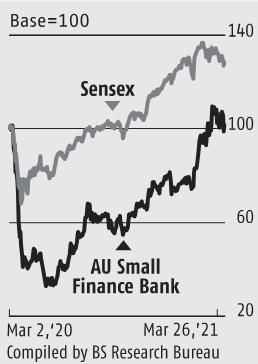Despite a shaky Q3, conviction over the stock remained high, with 65 per cent of the analysts polled on Bloomberg retaining their 'buy' recommendation.
Hamsini Karthik reports.

AU Small Finance Bank (AU SFB) raising equity capital at Rs 1,251 a share -- a premium of 5.6 per cent to its issue price -- is no mean feat, given its asset size of just Rs 33,200 crore.
This is because even larger peers such as Axis Bank and ICICI Bank couldn't raise capital at a premium.
However, after touching a 52-week high of Rs 1,315 apiece on March 9 (when it raised capital), the stock has corrected about 12 per cent to Rs 1,179.45, indicating the pressure in retaining premium valuations.
In comparison, the Sensex has shed 4 per cent from its intra-day high of March 9, and the BSE Bankex has fallen 7.7 per cent.
What helped AU SFB raise money at premium was the commitment from its management that the capital would be deployed towards building its balance sheet.
The capital adequacy ratio, coming in at over 20 per cent in the December quarter (Q3), also supported the narrative on equity issuance.
However, what is equally significant is that in Q3, gross non-performing assets (NPAs) shot up to 3.3 per cent, without considering the apex court's stay on asset classification.
Now, with an end to the impasse, the base will be reset in Q4.
However, since these levels are the highest seen by AU SFB after its 2017 listing, it will also be a litmus test to improve asset quality quickly.

Much of the pain was felt on account of its vehicle financing and small business loans books, which together account for 80 per cent of total assets.
With 62 per cent provision coverage in Q3, the March quarter may continue to see elevated provisioning cost.
"We see a risk of slippages and credit cost turning out to be higher than what the management has guided for, in the next two quarters," say analysts at Elara Capital.
However, those at Emkay Global reiterate that the bank's focus in the near term would be on managing asset quality.
Despite a shaky Q3, conviction over the stock remained high, with 65 per cent of the analysts polled on Bloomberg retaining their 'buy' recommendation.
It's valuation at 5x its FY22 estimated book positions the bank among the most expensive stocks in the financial sector.
The bank is progressing well on the liabilities front.
With its low-cost current account savings account (CASA) ratio at 22 per cent in Q3 -- up from 16 per cent a year ago -- and cost of funds down to 7 per cent from 7.5 per cent in FY20, elevated bad loans are only a blip for AU SFB.
Quickly rectifying will help retain pricey valuations.











